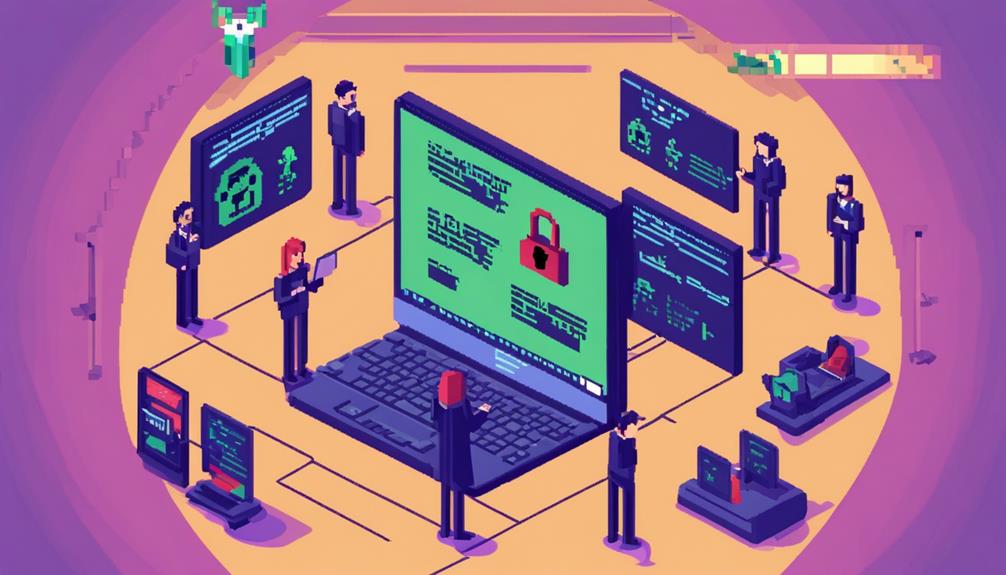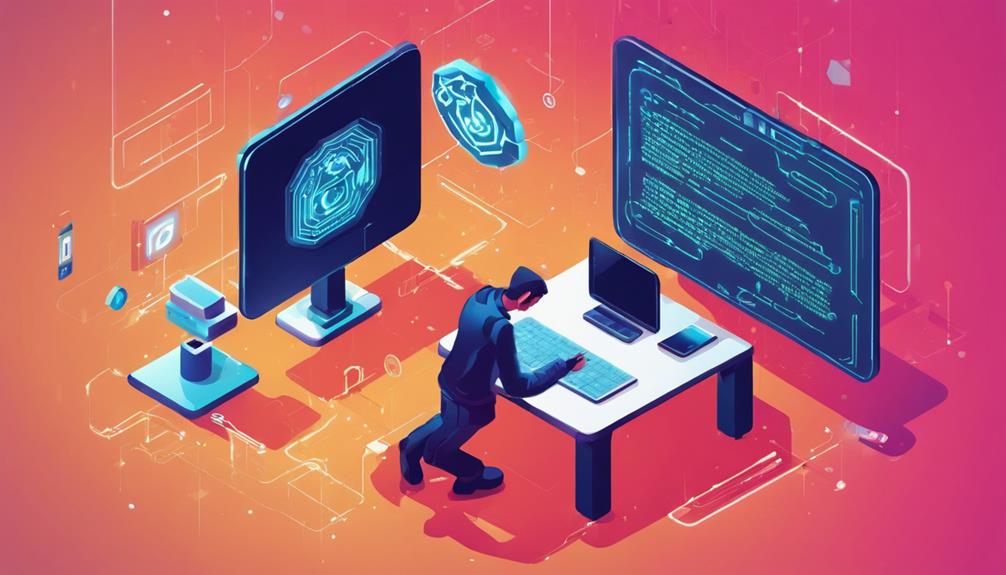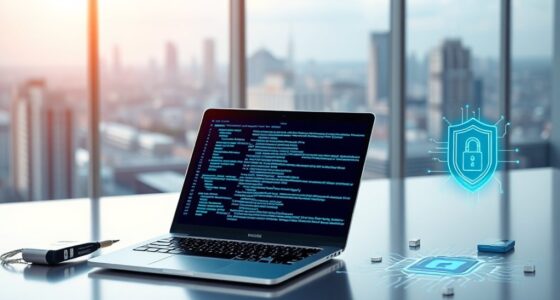In the domain of cybersecurity, hackers possess diverse roles. White hat hackers strengthen security, while black hats seek personal gain through malicious actions. Cybercriminal tactics include phishing for data, theft of personal and financial information, and ransomware attacks. Data breaches lead to financial and reputational losses, with an average cost of $3.86 million. Phishing scams deceive individuals into disclosing sensitive data, while ransomware causes major financial harm. Implementing multifactor authentication enhances security, and education on cyber threats is essential for protection. Understanding the scope of these risks is vital in safeguarding personal information from cyber threats.
Key Takeaways
- Hackers can steal personal & financial data for exploitation.
- Data breaches lead to financial losses & identity theft.
- Phishing scams trick individuals into divulging sensitive information.
- Ransomware attacks can cause significant financial losses.
- Multifactor authentication adds extra security layers to protect information.
Types of Hackers
Within the domain of cybersecurity, understanding the distinct categories of hackers is essential for comprehending the diverse motivations and actions within the digital landscape. Hackers know the value of sensitive information and operate within different ethical boundaries.
White hat hackers, also known as ethical hackers, are employed by organizations like IBM to test and enhance security systems, aiming to protect against cyber threats. On the other end of the spectrum are black hat hackers who engage in malicious activities, exploiting vulnerabilities for personal gain or causing harm.
Gray hat hackers fall in between, sometimes using their skills for both ethical and unethical purposes. These hackers can employ various tactics, such as spam campaigns, extortion schemes, phishing scams, and remote access trojans, to exploit individuals and businesses.
Understanding the distinctions between these hacker categories is vital in combating cyber threats and safeguarding sensitive data in an increasingly digital world.
Tactics of Cybercriminals
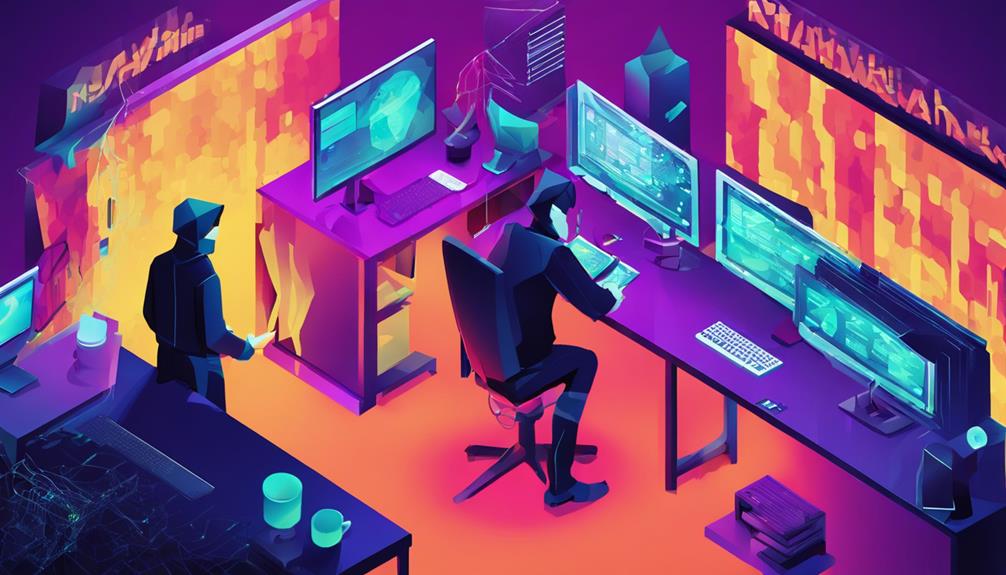
Cybercriminals employ various tactics to steal data and compromise security. One common method is through phishing scams, where hackers use deceptive emails to trick individuals into disclosing sensitive information like usernames and passwords.
These attacks can lead to severe consequences, highlighting the importance of staying vigilant against such threats.
Hacker's Data Theft
Hackers employ sophisticated tactics to steal valuable data, ranging from personal information to financial details, in order to carry out various forms of exploitation and fraud. Once hackers gain access to this data, they can execute malicious activities like identity theft and financial fraud through phishing attacks that target compromised user credentials.
The stolen data is often sold on the deep web, where cybercriminals engage in trading personal information, payment card details, and other valuable data. Moreover, ransomware attacks are utilized to hold data hostage for financial gain, coercing businesses into paying hefty sums to prevent potential damage and data exposure.
Various types of stolen data, including usernames, passwords, healthcare records, and education transcripts, are exploited by hackers for extortion and fraudulent activities. This underscores the importance of robust cybersecurity measures to safeguard personal and financial information from falling into the hands of cybercriminals.
Phishing Scams Explained
Phishing scams are deceptive schemes utilized by malicious actors to dupe individuals into divulging sensitive information through fraudulent emails or messages. These cybercriminals often mimic reputable entities like banks or government agencies to appear legitimate and trick recipients.
By preying on emotions like fear or urgency, phishing tactics aim to manipulate victims into clicking on harmful links, downloading attachments, or sharing confidential details. Common forms of phishing include fake invoices, account suspension alerts, and urgent pleas for financial aid.
The ultimate goal of these scams is to steal credentials, financial data, and personal information, resulting in identity theft, monetary losses, and unauthorized access to accounts for nefarious purposes. It is important for individuals to remain vigilant and cautious when interacting with emails or messages, especially when asked to provide sensitive information, to protect themselves from falling victim to these malicious phishing schemes.
Impact of Data Breaches
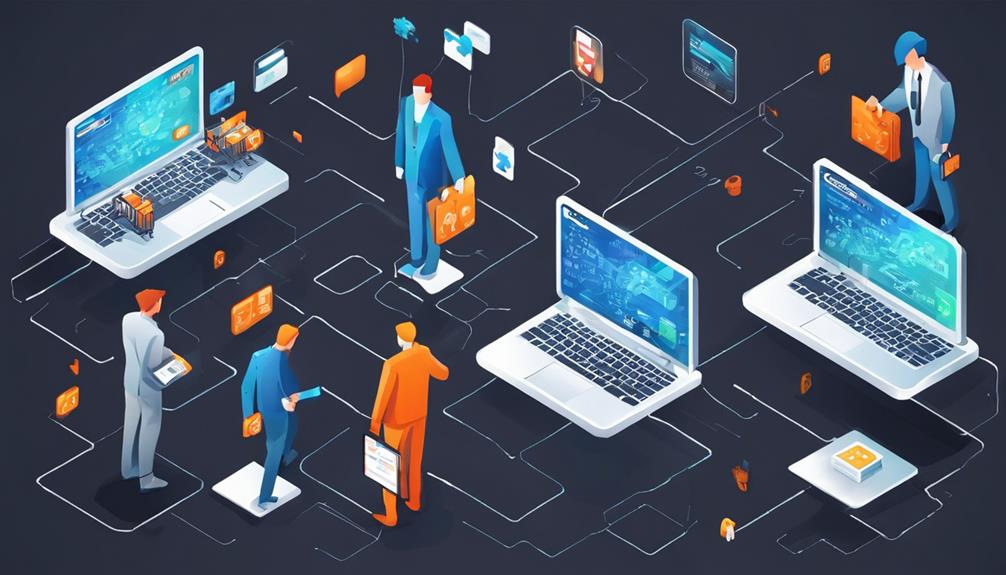
Data breaches can have severe consequences, resulting in significant financial losses for businesses and prolonged exposure to cyber threats.
When personal identifying information is exposed, individuals become vulnerable to identity theft and fraud, with each record being valued at around $250 on the dark web.
Additionally, the reputational damage from a breach can erode trust in a company's brand and have long-lasting effects on customer confidence.
Breach Consequences Explained
The repercussions of a data breach extend far beyond immediate financial costs, encompassing significant implications for businesses and individuals alike. Data breaches can result in substantial financial losses for businesses, with the average cost of a breach reaching $3.86 million in 2020.
The reputational damage from a data breach can be severe, leading to a loss of customer trust and loyalty. Personal information exposed in data breaches can lead to identity theft and fraud, affecting individuals' financial well-being.
Critical infrastructure can be disrupted as a result of data breaches, potentially jeopardizing public safety. Legal consequences, such as fines and lawsuits, can be imposed on organizations that fail to adequately protect sensitive data from breaches.
Personal Data Vulnerability
Personal data vulnerability underscores the critical importance of robust cybersecurity measures in safeguarding sensitive information from malicious actors. Data breaches pose a significant threat to individuals and organizations, with personal identifying information (PII) being a prime target for cybercriminals.
In 2020 alone, over 8.4 billion records were exposed in data breaches, emphasizing the widespread impact of cybersecurity vulnerabilities. The consequences of such breaches can be severe, with businesses facing an average cost of $3.86 million per breach. Stolen PII is often sold on the deep web for exploitation, highlighting the risk of identity theft and fraud faced by individuals.
Additionally, delays in identifying data breaches are common, with organizations taking an average of 280 days to detect and contain a breach. Lack of prioritization of cybersecurity leaves businesses vulnerable, as many underestimate the risks of cyberattacks and the potential consequences of compromised data.
Trust Erosion After Breach
Trust erosion following a breach is a critical concern for organizations, as consumer confidence dwindles greatly when data security is compromised. The impact of data breaches goes beyond financial losses, affecting customer loyalty and brand reputation.
Here are key points to take into account:
- Consumer Confidence: 60% of consumers lose trust in businesses that fail to safeguard their data, leading to a significant decrease in confidence levels.
- Brand Loyalty: 74% of consumers are inclined to switch brands post-breach, highlighting the substantial impact on customer loyalty and retention.
- Financial Implications: Data breaches incur an average cost of $3.86 million for organizations, encompassing recovery expenses, fines, and legal consequences.
- Industry Vulnerability: The healthcare sector faces the highest average cost per breached record at $429, making it a prime target for cybercriminals seeking valuable data.
Data breaches not only result in immediate financial burdens but also pose long-term challenges related to trust, customer relationships, and organizational reputation.
Risks of Phishing Attacks

One of the most prevalent threats in the cybersecurity landscape is the risk posed by phishing attacks. Phishing attacks involve hackers using deceptive emails to trick individuals into divulging sensitive information such as usernames, passwords, and financial details. These scams often masquerade as legitimate entities to lure recipients into clicking on malicious links or downloading harmful software.
If successful, phishing attacks can result in compromised credentials, opening the door to identity theft, financial fraud, and unauthorized access to personal or corporate data.
With over 1.5 million new phishing sites cropping up each month, vigilance and awareness are vital in thwarting these threats. Phishing attacks heavily rely on social engineering tactics to exploit human vulnerabilities, making it essential for individuals to exercise caution when interacting with emails and other online communications.
Dangers of Ransomware
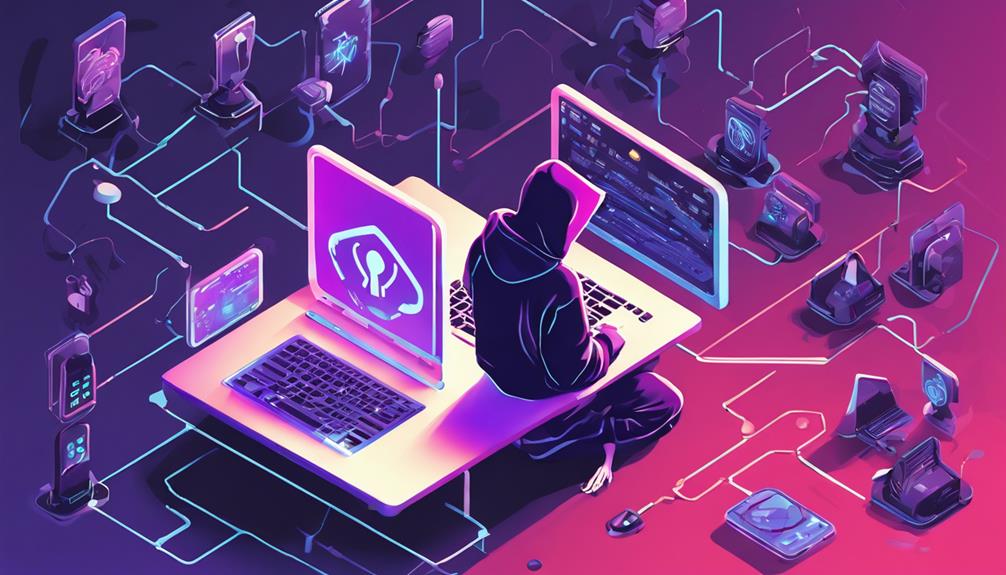
The prevalence of ransomware poses a significant threat in the cybersecurity landscape, with cybercriminals utilizing this malicious software to encrypt files and extort payment from victims. Ransomware has become a lucrative tool for cybercriminals, causing global damages exceeding $20 billion in 2021 alone.
Here are some key points to contemplate regarding the dangers of ransomware:
- Ransomware attacks can lead to significant financial losses for individuals and businesses, with cybercriminals often demanding substantial sums, averaging around $170,000 in 2021.
- Victims of ransomware face tough choices, as paying the ransom does not guarantee the safe recovery of their data.
- Industries such as healthcare, government, and education are particularly vulnerable to ransomware attacks, given the sensitive nature of their data.
- Ransomware can also be used in conjunction with other cyber threats like business email compromise and credit card fraud, amplifying the risks faced by individuals and organizations.
Importance of Multifactor Authentication
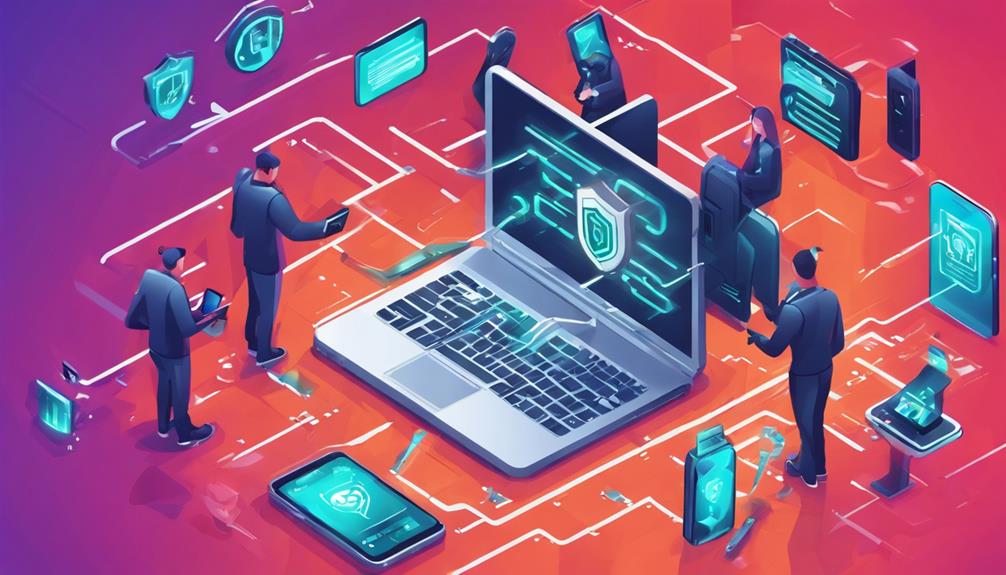
Enhancing digital security measures, multifactor authentication plays a crucial role in safeguarding sensitive information from unauthorized access. Multifactor authentication goes beyond traditional passwords by requiring users to provide additional forms of verification, such as SMS codes, biometric scans, or physical security keys. This added layer of security greatly reduces the risk of unauthorized access to accounts.
Here is a table illustrating the effectiveness of multifactor authentication:
| Benefits of Multifactor Authentication |
|---|
| Adds an additional security layer beyond passwords |
| Requires multiple forms of verification |
| Substantially reduces unauthorized access risk |
Implementing multifactor authentication can prevent a vast majority of account breaches, with studies showing that it can stop up to 99.9% of unauthorized access attempts. By combining multifactor authentication with strong passwords, individuals can greatly enhance the security of their online accounts and protect their sensitive information from cyber threats.
Cybersecurity Education for All
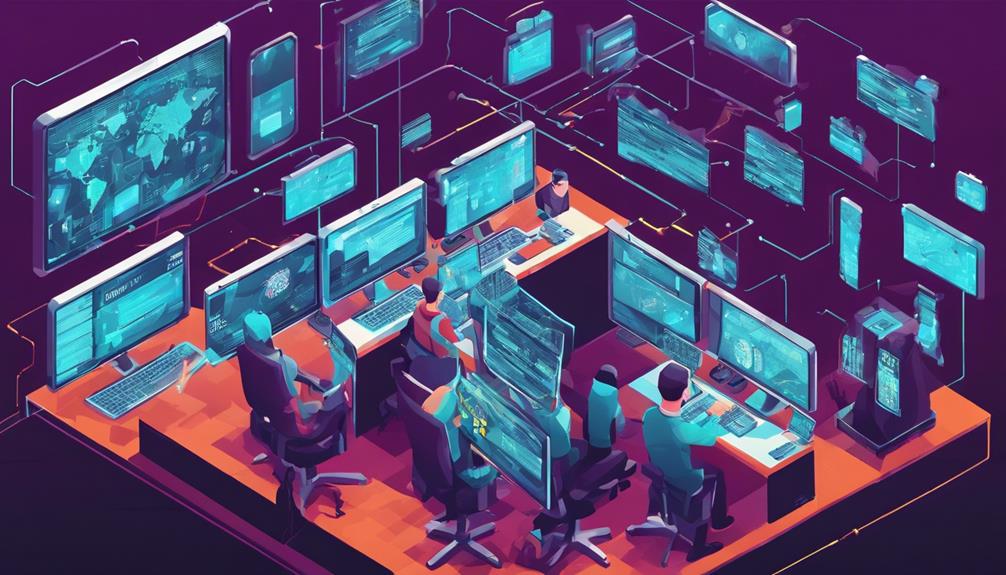
Understanding the fundamentals of cybersecurity is essential for individuals of all backgrounds to effectively protect themselves against evolving cyber threats. With the rise of data breaches and hacking incidents, cybersecurity education plays a vital role in safeguarding personal information. Here are key points highlighting the importance of cybersecurity education:
- Awareness of Risks: Individuals learn how hackers exploit personal information, enabling them to take proactive measures.
- Recognizing Scam Tactics: Education helps in identifying common phishing attempts and avoiding falling victim to cybercriminals.
- Consequences of Breaches: Understanding the potential impact of data breaches empowers individuals to prioritize cybersecurity measures.
- Staying Informed: Cybersecurity education equips individuals to stay updated on security alerts, data breaches, and emerging cyber threats.
Mitigating SQL Injection Threats
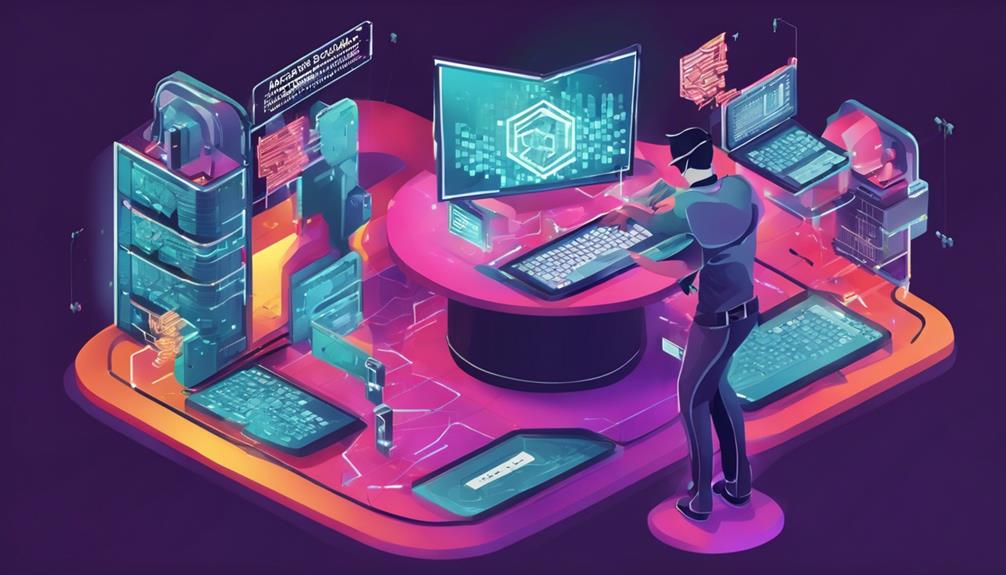
To combat the prevalent risk of SQL injection attacks, organizations must prioritize robust security measures to safeguard their databases and sensitive information effectively.
SQL injection is a common cyberattack method where hackers inject malicious code into SQL databases, exploiting backend vulnerabilities in websites or applications. This type of attack poses a serious threat to data security, with automated programs readily available to execute SQL injection attacks effortlessly.
The consequences of such attacks can be severe, ranging from data breaches and financial losses to damage to an organization's reputation. Hence, it is essential for businesses and individuals to implement strong security measures to prevent and mitigate SQL injection threats.
By regularly updating software, using parameterized queries, employing web application firewalls, and conducting security audits, organizations can significantly reduce the risk of falling victim to SQL injection attacks and protect their valuable data.
Prioritizing data security is key in the ongoing battle against cyber threats like SQL injection.
Future of Cyber Protection

What key cybersecurity measures are essential for ensuring effective protection in the future?
As cyber threats continue to evolve, implementing robust security measures is critical to safeguard sensitive information.
Some key strategies for enhancing cyber protection include:
- Multifactor authentication: By requiring users to provide multiple forms of verification, such as a password and a unique code sent to their phone, this method adds an extra layer of security.
- Strong passwords: Using complex passwords that combine letters, numbers, and special characters can greatly improve the resilience of accounts against hacking attempts.
- Education and prevention: Educating individuals about cybersecurity best practices and promoting cautious web behavior can help prevent falling victim to common cyber threats.
- Continuous advancements in cybersecurity technologies: Investing in cutting-edge security solutions and staying updated on the latest trends in cyber defense can strengthen overall protection against emerging threats.
These measures, when implemented effectively, can play an essential role in fortifying cybersecurity defenses for the future.
Frequently Asked Questions
What Happens if a Hacker Gets Your Personal Information?
If a hacker obtains your personal information, they can engage in identity theft, financial fraud, unauthorized transactions, extortion, and healthcare misuse. Safeguarding sensitive data is essential to prevent cybercriminals from exploiting it for malicious purposes.
What Could the Hacker Do With the Information They Obtained?
In the hands of a hacker, stolen information transforms into a dangerous tool for extortion, fraud, and identity theft. Personal data like PII and financial details can be sold, while compromised credentials open pathways to ransomware, phishing, and various cybercrimes.
What Do Hackers Want From My Phone?
Hackers target phones to obtain valuable personal identifying information, financial data, and access to emails and social media accounts. They may exploit security vulnerabilities to install malware or ransomware for financial gain, and even remotely access cameras and microphones for surveillance.
What Is Cyber Security 101?
Cybersecurity 101 serves as the foundational knowledge base for safeguarding digital assets against malicious cyber threats. It encompasses understanding common risks, implementing best practices, and educating on preventive measures to mitigate vulnerabilities and protect sensitive information.
Conclusion
In summary, understanding the various tactics and dangers posed by hackers is essential in today's digital age.
It is vital to educate oneself on cybersecurity measures such as multifactor authentication and mitigation strategies like SQL injection prevention.
By staying informed and implementing proper security measures, individuals and organizations can better protect their sensitive information from cyber threats.
Awareness and proactive measures are key in safeguarding against the alarming realities of cybercrime.

